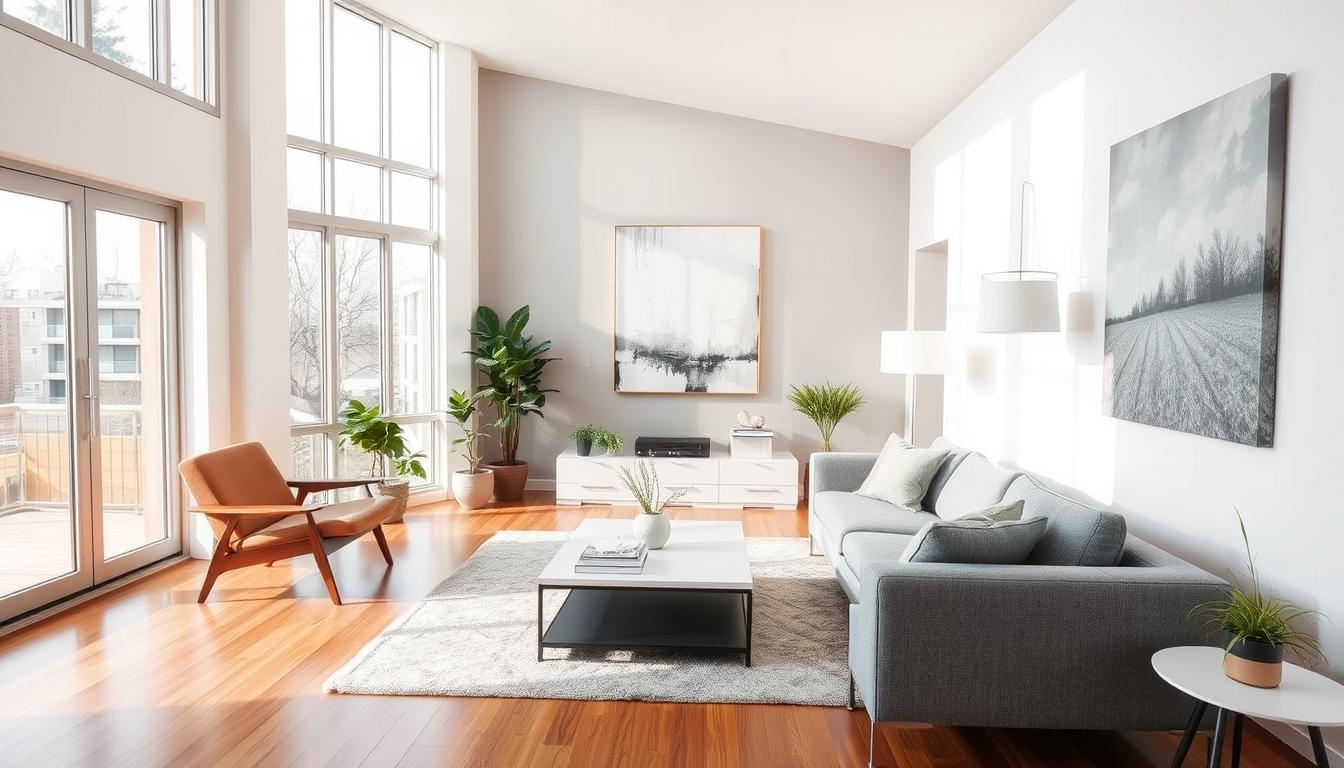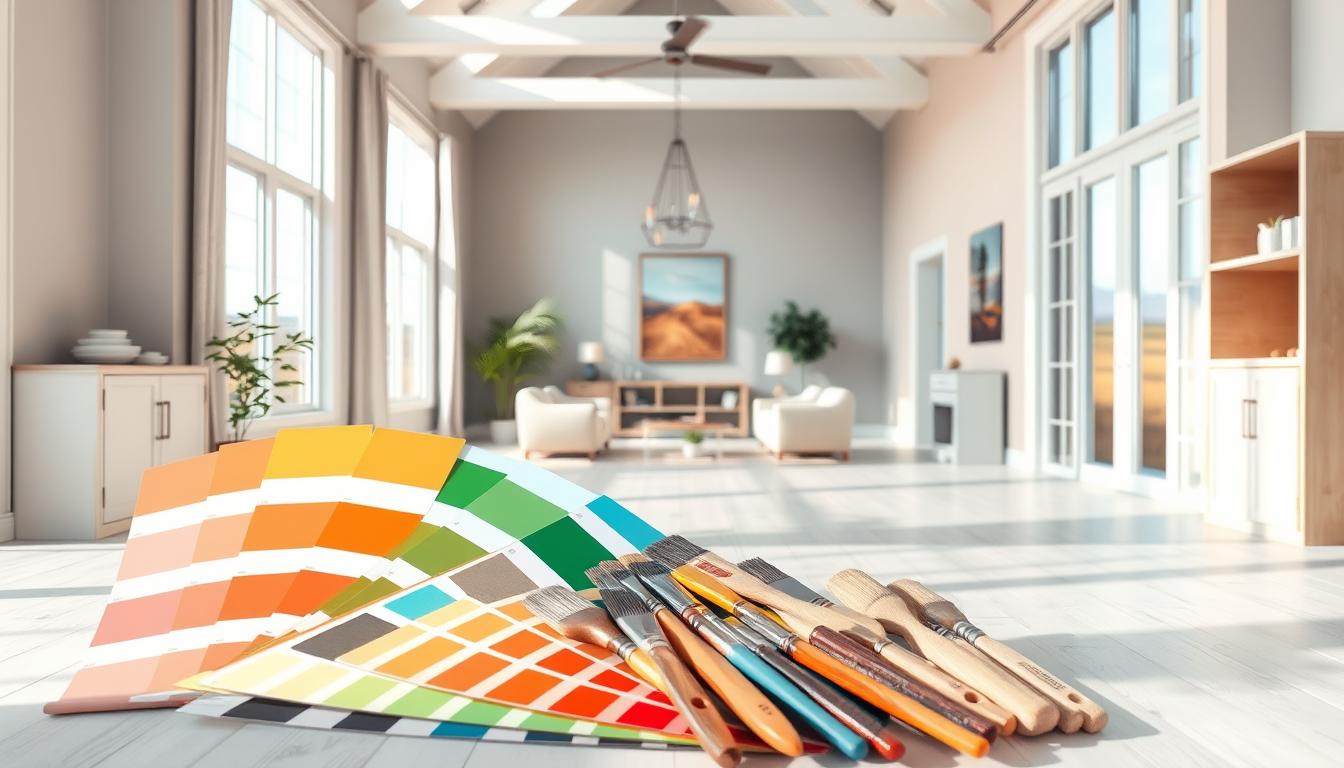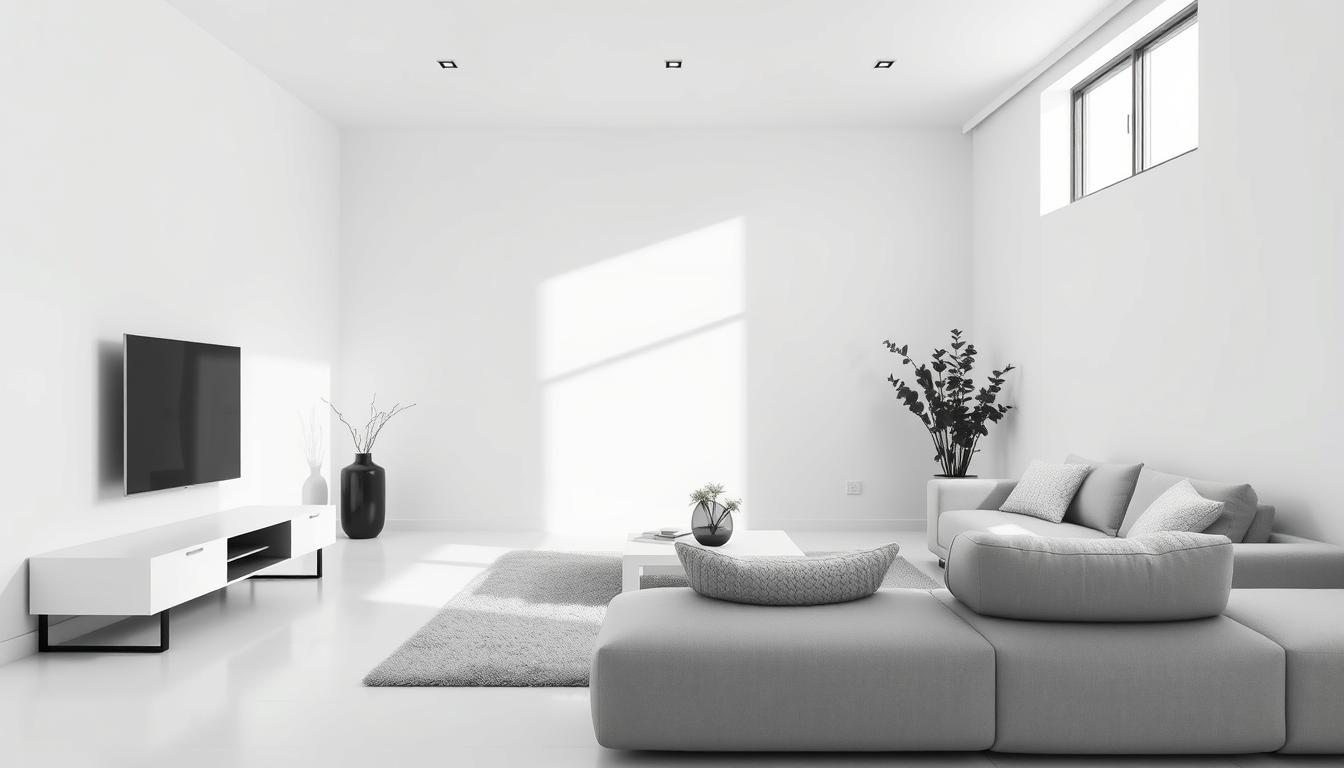Did you know that our living spaces’ interior design can really affect our mood and how productive we are? A well-designed home can boost our overall well-being. When we aim to create our perfect haven, we face many design options.
Choosing the right style can be tough with so many options. We’ll look at the different interior design styles that can make our living spaces cozy and stylish.
Key Takeaways
- Understanding the impact of interior design on our well-being.
- Exploring the variety of design styles available.
- Identifying the key elements of each style.
- Learning how to choose the right style for our space.
- Discovering how to mix and match different styles.
Understanding the Importance of Interior Design
Interior design is key in our daily lives. It shapes our mood, productivity, and well-being. The design around us matters a lot.
It’s not just about looks. Interior design makes spaces functional and comfy. A good design boosts our energy and brings calm.
The Role of Design in Our Lives
Design is a big part of our daily life. It changes how we feel and act. Effective interior design makes spaces better to use and enjoy.
- Creates a sense of harmony and balance
- Improves the functionality of a space
- Reflects the personality and style of the occupants
Benefits of a Well-Designed Space
A well-designed space is good for our health. It uses natural light, colors, and comfy furniture. This supports our well-being.
Some key benefits include:
- Increased productivity: A well-designed space helps us stay focused and work better.
- Enhanced mood: The right colors, lights, and textures can make us feel better.
- Better health: Good design reduces stress and helps us relax.
Understanding interior design’s role in our lives helps us make better choices. Whether we like modern, traditional, or a mix, the goal is to create a space that’s both beautiful and useful.
Traditional Interior Design Style
The traditional interior design style is known for its timeless elegance. It uses rich colors, ornate patterns, and antique furniture. This creates a sophisticated and welcoming atmosphere in any home.
Key Characteristics of Traditional Design
Traditional interior design is all about symmetry and order. It features balanced compositions and classic furnishings. This style focuses on comfort and elegance, making it a favorite for those who love heritage and luxury.
The use of rich textiles like velvet, silk, and linen is common. These add depth and warmth to rooms. Traditional design also includes intricate patterns and ornate details in furniture, rugs, and accessories.
Popular Color Palettes and Materials
Traditional design often uses a warm and muted color palette. Shades of beige, cream, and soft pastels are popular. Earthy tones and rich jewel tones also add luxury and sophistication.
Materials like wood, metal, and stone are key in traditional design. These natural materials are used in furniture and decorative elements. They contribute to the style’s classic and enduring appeal.
Iconic Furniture and Décor Items
Iconic furniture in traditional design includes antique armchairs, ornate sofas, and intricately carved wooden tables. These pieces are known for their detailed craftsmanship and classic shapes.
To add an eclectic touch to a traditional space, consider unique decorative items or vintage accessories. This can make your space personalized and visually interesting, showing off your style.
Modern Interior Design Style
The modern interior design style focuses on clean lines and minimal ornamentation. It emphasizes functionality and creates a sense of openness and flow. This design is not just about looks; it’s about making a space feel open and functional.
Defining Elements of Modern Design
Modern design uses minimalist principles, focusing on the essentials and eliminating clutter. This makes a space look sleek and contemporary while enhancing its functionality.
One key element of modern design is clean lines and minimal ornamentation. Furniture and decorative items are designed simply, avoiding intricate patterns and excessive detailing.
Minimalism and Functionality
At the heart of modern design is minimalism. This means stripping away unnecessary elements to reveal a space’s essence. Minimalist design is not just about using fewer items; it’s about using the right items that serve a purpose.
Functionality is crucial in modern design. Every piece of furniture or decor is chosen for its utility, not just its looks. This ensures a space is beautiful, livable, and efficient.
| Design Element | Modern Design Characteristics |
|---|---|
| Furniture | Simple, functional, and minimalist |
| Color Scheme | Neutral tones with occasional bold accents |
| Lighting | Emphasis on natural light, supplemented by minimalist lighting fixtures |
Emphasis on Natural Light
Natural light is key in modern interior design. Large windows, skylights, and mirrors are used to let in more natural light. This creates a sense of openness and connection to the outdoors.
By focusing on natural light, modern design reduces the need for artificial lighting. It also enhances the ambiance of a space, making it feel more welcoming and spacious.
For more insights into different home interior design styles, you can explore our article on exploring the different home interior design styles we.
Contemporary Interior Design Style
Contemporary interior design is always changing. It shows off today’s trends and styles. It’s all about being new and creative.
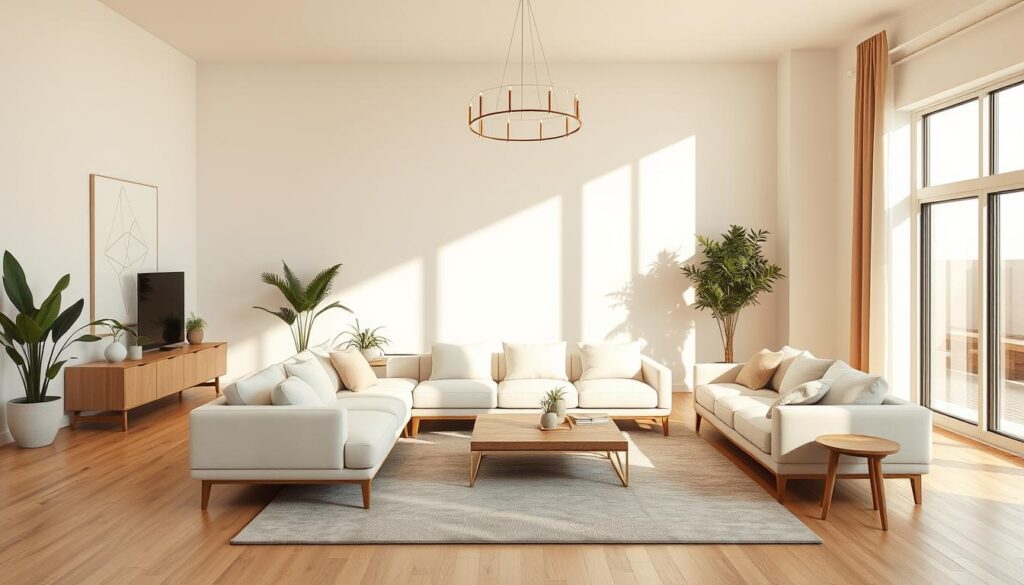
Many people mix up contemporary with modern design. But they are not the same. Knowing the difference is key.
Differences Between Modern and Contemporary
“Modern” and “contemporary” are often confused. But they mean different things. Modern design is from the mid-20th century. It’s all about clean lines and being functional.
Contemporary design is more flexible. It uses today’s trends, materials, and tech. It’s not stuck to one style.
Key Features of Contemporary Spaces
Contemporary spaces love open layouts and natural light. Big windows and mirrors make them bright. They also mix materials like wood, metal, and glass for interest.
The colors in contemporary design can be anything. From calm to bold, it depends on the mood. Furniture is simple and functional, with clean lines.
Trends in Contemporary Design
Today, contemporary design focuses on sustainability and eco-friendly materials. It’s all about caring for the planet. Technology is also big, with smart homes becoming common.
It’s also becoming more personal. People want unique touches that show who they are. This can be custom furniture, art, or decorations.
Rustic Interior Design Style
If you adore the countryside, rustic interior design is ideal. It offers a warm, cozy, and welcoming vibe. You’ll find natural materials, earthy tones, and vintage touches.
The Charm of Rustic Aesthetics
Rustic design turns a house into a home. It uses natural materials like wood, stone, and brick. These add texture and depth. Earthy colors bring calm and serenity.
Natural Materials and Textures
Natural materials are key in rustic design. Wooden beams, stone fireplaces, and brick walls are common. They add texture and make the space feel real and cozy.
Adding different textures, like stone’s roughness or wood’s smoothness, makes the space more engaging. Natural fibers like wool and linen in furniture and decor enhance this.
How to Achieve a Cozy Feel
To make a rustic space cozy, focus on warmth and comfort. Use candles and fireplaces for light. Add plush textiles like throw blankets and pillows. The goal is to make it inviting and comfy.
Mixing in styles like farmhouse or coastal can add interest. A farmhouse kitchen with rustic cabinets and a big island is both functional and cozy. Coastal elements like shells or driftwood can also spice up a rustic living room.
Industrial Interior Design Style
Industrial interior design celebrates the raw and unfinished. It turns old factories and warehouses into trendy homes. This style is loved for its modern and practical vibe.
Characteristics of Industrial Design
Industrial design uses raw materials and focuses on function. You’ll see exposed brick, metal beams, and reclaimed wood. These features add character and history to any space.
Key Features of Industrial Design:
- Exposed structural elements like beams and ductwork
- Use of raw materials such as concrete, steel, and wood
- Minimal ornamentation, focusing on functionality
- Open floor plans that create a sense of spaciousness
Incorporating Raw Materials
Using raw materials is key in industrial design. They add texture and depth. Reclaimed wood, for example, brings warmth to cold spaces.
Tips for Incorporating Raw Materials:
- Use reclaimed wood for furniture or accent walls
- Incorporate metal accents through lighting fixtures or decorative items
- Exposed concrete can be used for flooring or walls
Color Schemes for Industrial Spaces
Industrial design favors neutral colors. Shades of gray, brown, and beige are common. They create a calm background for the raw materials.
Popular Color Schemes:
- Monochromatic neutrals like various shades of gray
- Earth tones that complement the natural materials
- Bold accents to add contrast and visual interest
By mixing industrial and modern elements, you can make a space that’s both unique and welcoming.
Mid-Century Modern Design Style
Mid-Century Modern design is more than a style; it’s a mix of function and simple beauty. It started in the 1930s to 1960s and has greatly influenced interior design.
Origins and Evolution
The Mid-Century Modern style came after World War II. It focused on open and airy homes. This change was due to new materials and technologies.
Design historian Stephen J. Phillips said, “Mid-Century Modern design was about more than looks. It was about creating a modern way of living.”
“The emphasis was on clean lines, minimal ornamentation, and an integration with nature.”
Design Elements That Stand Out
Key elements of Mid-Century Modern style include:
- Clean lines and minimal ornamentation
- Organic shapes and geometric forms
- An emphasis on functionality
- Integration with nature through large windows and outdoor spaces
Iconic Design Elements include new materials like plywood and aluminum. These allowed for creative furniture designs.
Iconic Mid-Century Furniture
Furniture is vital in Mid-Century Modern design. Iconic pieces include:
| Furniture Piece | Designer | Characteristics |
|---|---|---|
| Eames Lounge Chair | Charles and Ray Eames | Molded plywood, leather upholstery |
| Tulip Table | Eero Saarinen | Cast aluminum base, round tops |
| Noguchi Coffee Table | Isamu Noguchi | Simple, sculptural design |
These pieces show the design principles of Mid-Century Modern. They have also become classics in interior design.
Bohemian Interior Design Style
The bohemian style is all about mixing different things together. It’s about creating a space that feels unique and full of life. This style is all about expressing yourself through your decor.
Bohemian design is all about embracing individuality. It’s about taking different styles and making them your own. This means combining vintage pieces with modern ones, and adding in lots of textiles and patterns.
When you think of bohemian design, you might think of colorful rugs, macrame wall hangings, and lots of plants. These elements add a sense of warmth and coziness to a room. They make it feel like a place where you can relax and be yourself.
Bohemian design is all about creating a space that feels like your own. It’s about mixing different styles and creating a unique atmosphere. Whether you’re into vintage, modern, or eclectic, bohemian design allows you to express your personality through your decor.
So, if you’re looking to add some bohemian flair to your home, start by mixing different styles together. Add vintage pieces, modern furniture, and lots of textiles and patterns. Don’t be afraid to experiment and have fun with it. After all, bohemian design is all about embracing individuality and creating a space that feels like your own.
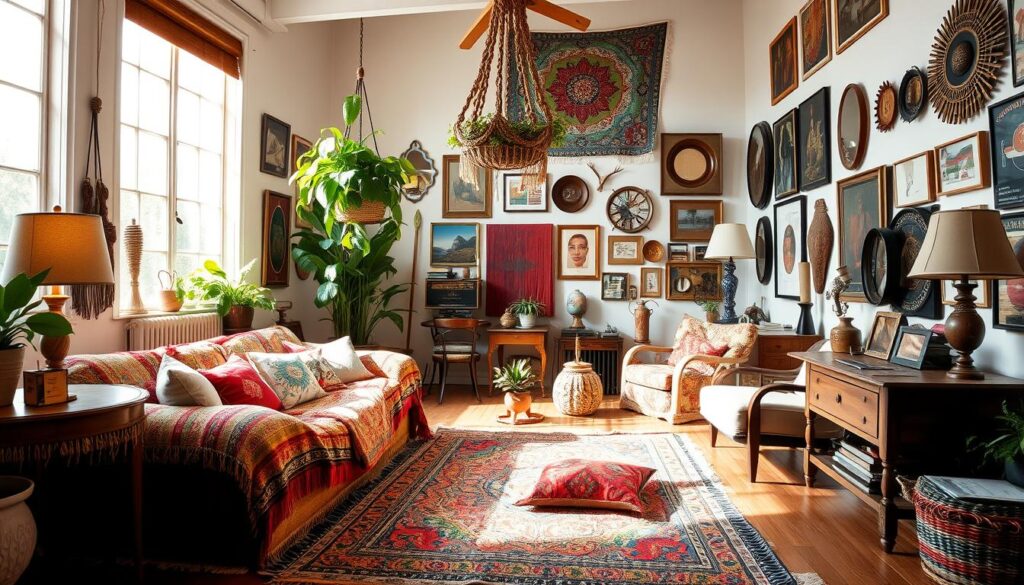
Bohemian Interior Design Style
| Key Elements of Bohemian Interior Design Style | Examples |
|---|---|
| 1. Mixing different styles | Vintage furniture, modern artwork, eclectic accessories |
| 2. Embracing individuality | Unique textiles, handmade items, personal mementos |
| 3. Creating a cozy atmosphere | Colorful rugs, macrame wall hangings, plenty of plants |
| 4. Expressing personality through decor | Personalized artwork, statement pieces, eclectic accessories |
Farmhouse Interior Design Style
The farmhouse interior design style is loved for its cozy feel. It mixes old and rustic elements to make homes feel welcoming.
The Allure of Modern Farmhouse
Modern farmhouse design combines old charm with new comforts. It uses natural materials like wood and stone for warmth. Mixing vintage furniture with modern decor makes a space unique and personal.
Incorporating Vintage and Rustic Items
To add to the farmhouse style, we can use vintage and rustic items. Antique furniture and distressed finishes bring character. Natural elements like burlap and reclaimed wood add warmth. A focal point, like a vintage door, can really make a space stand out.
Color Schemes for Farmhouse Style
Choosing the right colors is key for the farmhouse look. Traditional colors include shades of white, cream, and beige. Earthy tones like sage green and terracotta add warmth and coziness.
| Color | Hex Code | Description |
|---|---|---|
| Soft Cream | #F5F5DC | Warm and inviting |
| Distressed Wood | #969696 | Weathered wood tone |
| Sage Green | #8B9467 | Earthy and calming |
By following these tips, we can make a farmhouse-style home that’s both warm and inviting.
Selecting the Right Design Style for Us
When we look at different home interior design styles, we must think about what fits our space best. We’ve seen many styles, from traditional to modern, each with its own special features.
Assessing Space and Needs
To pick the right style, we need to look at our space and needs. Think about the room’s purpose, our lifestyle, and what we like. This helps us choose the best design for us.
Combining Styles
We can mix different styles to make a unique look. For example, combining modern and contemporary can create a sleek, sophisticated feel. Mixing styles lets us show our personality and make a space that’s truly ours.
Making Personalized Choices
In the end, our design choices should show who we are. By thinking about what we like and need, we can make smart choices. This way, we can create a beautiful, functional home that’s just right for us.

